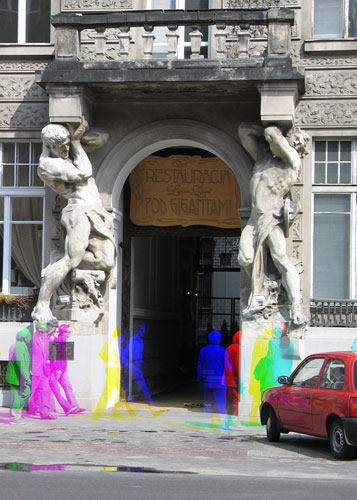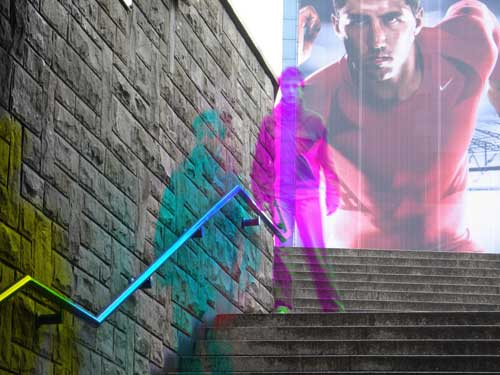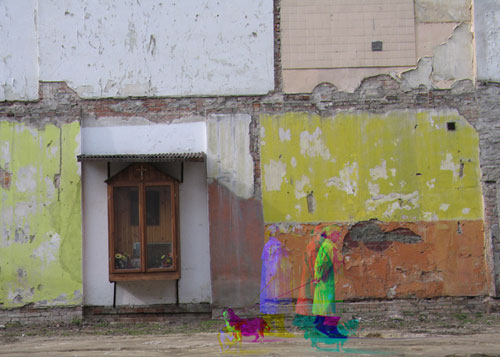
The Parallax of Time
9.II - 9.III.2007
9.II - 9.III.2007

colour photography, original size 50x70 cm

colour photography, original size 50x70 cm

colour photography, original size 50x70 cm

colour photography, original size 70x50 cm
Portrait of time is an abstract picture
There is a complex history behind mutual relations between art and technology: we can distinguish periods when those two spheres seem to be closely connected, and times when in general opinion there can be nothing more remote and different. The period of the "first avant-garde" of the 1920s of the previous century was especially favourable as far as the search for new approaches in art through its links with technology was concerned; mechanical origins of photography became an impulse that made the artists employ photography widely with the intention of renewing the language of art. It is worthy of note that the interest in technology in the context of art might be interpreted at its foundations in two radically different ways. The first one, taking its source in constructivism, exposes the objective and rational nature of technology; the second one, futuristic and dadaistic, sees technology and its product - the machine - as the domain and effect of "modern magic", another world full of poetic mysteries.
In the period of the last thirty years, when Zbigniew Tomaszczuk was working in the field of photography, technical problems connected with this medium often turned out to be a source of inspiration for him - both in his work as a teacher, theoretician and an editor of photographic journals, and in his own artistic endeavours. For example in his series from 1996, called "Pinhole-TV-Polaroid", he exploited an idea of an artistic hoax, suggesting to the viewers that in the future it would be possible to construct a contraption that could represent television images, registered for a long time (up to an hour or more) on pinhole polaroid photographs, in their original form - as moving pictures. The hoax was an expression of a dream to recapture lost time. And of an idea that lost time, compressed in layer upon layer, can be found in light-sensitive photographic emulsion.
In his latest series called "The Parallax of Time" Zbigniew Tomaszczuk's inspiration is the technology of the production of a colour photographic image. And like in his previous work, the technological problem, presented in its entire rationality and practical literalness, gains new meaning which is not so obvious and common any more. The meaning of those photographs comes into being somewhere "in between": between objective reality and its subjective interpretation, expressed by means of a photographic picture.
The photographs depict images of city squares and streets - the views are plain, as if registered by an amateur-tourist. There is nothing special in those pictures - except human figures which fade into colourful silhouettes: red, green and yellow. This is because each frame contains three pictures of the same image, taken one by one in successive expositions, in short time intervals; in each case the author used a different colour filter, eliminating a part of the colourful triad that makes up the full colour of the photograph. Whatever is motionless in reality - buildings, trees, sidewalks, advertisement posters, billboards and the sky - looks like it ought to in a colour photograph. Only the people who move seem to be in two or three places at the same time, changing simultaneously into their own flat, spectral shadows, as if painted in colour ink by the artist. Photographed human silhouettes change into abstract paintings, losing before the viewers' eyes the features of realistic, documentary reflection, ascribed to photography. Paradoxically, motionless and vivid faces from billboard ads, which due to their size dominate over tiny human silhouettes, seem more realistic.
Thanks to the uncomplicated technical interference into the process of producing an image, the author split the time contained in such triple frames. By means of a specific "time shift", analogical to the spatial parallax, taking place within the camera lens, Tomaszczuk has shown that one can achieve something apparently impossible in a motionless picture and represent the passage of time directly. However, the price to be paid for this representation is making the image look unreal and changing it into an abstract picture. In "The Parallax of Time" the features of photography, resulting from its chemical and physical characteristics, begin to reveal a strange depth, hidden under the rational structure, that cannot be grasped by the human mind. Breaking up the image of a moving passer-by into separate time phases, those photographs demonstrate a philosophical paradox of the overlapping of essence and existence. Regardless of detailed scientific theories which describe the world, we are still unable to understand how it is possible that in spite of constant changes taking place in time within our organisms we can still retain the feeling of identity of our selves, and - at the same time - we cannot return to any past state of our selves, even such that lasted only for a single second.
Zbigniew Tomaszczuk's latest series of photographs leads the viewers to the narrow edge of knowledge which separates what is known and obvious from what is unexplored and mysterious, mind-boggling due to its abyssal depths. But here the author is also presenting two sides of photography: its material aspect, in which it can be manipulated by means of technology, and its mental aspect, contained in our imagination and interpretation. These are the objective and subjective sides of photography which exist inseparably within an image which ought to stick to reality without causing any anxiety - but which sometimes "comes off" off the surface of reality. Therefore, when we see "in action" the process of transformation of concrete objects (and all the more so, humans!) into their abstract images, it is difficult not to feel rather uneasy.
In the approach of the author to those pictures we can also notice his awareness that we can control the material world by means of technology, and his belief that under all this something more is hiding, something that surely reaches far beyond this sphere which is still accessible to man. We can find such meanings in his works that differ from the meanings found in the works of constructivist artists, stressing the belief that the whole real world can be explored. On the other hand, it is also a world different from a slightly naive world of the futurists and dadaists who revealed surprising magic in man-made objects. This postconstructivist and postdadaistic contemporary awareness approaches all things, seeing them in their double nature: on the one hand, as something explorable and usable in practice, on the other - as something mysterious that escapes our intellect.
Frames by Zbigniew Tomaszczuk that came into being by means of a triple exposition are something like a pre-film in which successive frames, instead of being arranged in sequence, one by one, are bonded together into one motionless picture. Movement suddenly frozen becomes its own opposite, revealing the strange absurdity of the position of the object presented in such a way. Jacques-Henri Lartigue photographed his family and friends with similar intent, while they were jumping, falling or racing, because he clearly saw the chasm opening between reality and its photographic image. During the hundred years that have passed since then the photographic medium was gradually employed more and more widely, and the viewers, as well as the artists, slowly became immune to the astonishing features of the kind of image which made for "the magic" of photography in the first few decades of the existence of this new branch of art. In "The Parallax of Time" this "strangeness of being" of the photographic image and at the same time of the reality which it represented was discovered anew - by means of a simple technical operation which unexpectedly demolished the obviousness and banality of the simple colour photograph.
The fascination with the subject of the image itself does not appear in Tomaszczuk's works for the first time. An image that replaces reality was shown, for example, at the exhibition called "Images Which I Remember from the Past" (1999), whose starting point was a performance that employed a television image. Earlier the meaning of many works by Tomaszczuk was based on a surprising difference between the image and an unimpeded view of the reality perceived: one of them was a triptych called "Reflection" (1988) - a beautiful reflection on the nature of photography - in which two children look at their reflection in the water: later the children leave, but their reflection remains. This sequence of pictures also made use of a certain simple technical operation, employed during the process of making a print - namely, photomontage. In his series "Found Painting" (2000) and "Specific Places" Tomaszczuk hunted for accidental situations in city streets which - when photographed properly - could pass as abstract paintings. In this way the artist entered the field of theoretical reflection on the status of a work of art (using the example of a painting image and the way it functions in the artistic world in the form of a reproduction) in contemporary art-world. The series "Sweet Poland" (2001-2002), on the other hand, concentrated primarily on the way advertisement pictures function in metropolitan spaces in which due to their influence a strange amalgamation of reality and fiction takes place.
In the photographs from "The Parallax of Time" we can find as many as three themes important for Tomaszczuk: time, image and the city. The city for him is principally a place where man's natural environment consists of man-made objects, products of civilization; the images he treats as the most intriguing of those products which can change the character of the surrounding reality; while time for him is the most mysterious feature of our reality as it can be captured only when we "see" it thanks to its painful absence in a frozen photographic image. Trying to "catch" time and to portray it, i.e. to imagine it, we absolutely have to change it into an abstraction - this is what these photographs seem to be saying. And along with time - we also change ourselves into an abstract image.
January 2007, Elżbieta Łubowicz

colour photography, original size 50x70 cm

colour photography, original size 50x70 cm

colour photography, original size 50x70 cm

Exhibition organized as part of an
OPERATIONAL PROGRAMME
"Art Promotion"
Copyright ©2007 Galeria FF ŁDK, Zbigniew Tomaszczuk, Elżbieta Łubowicz